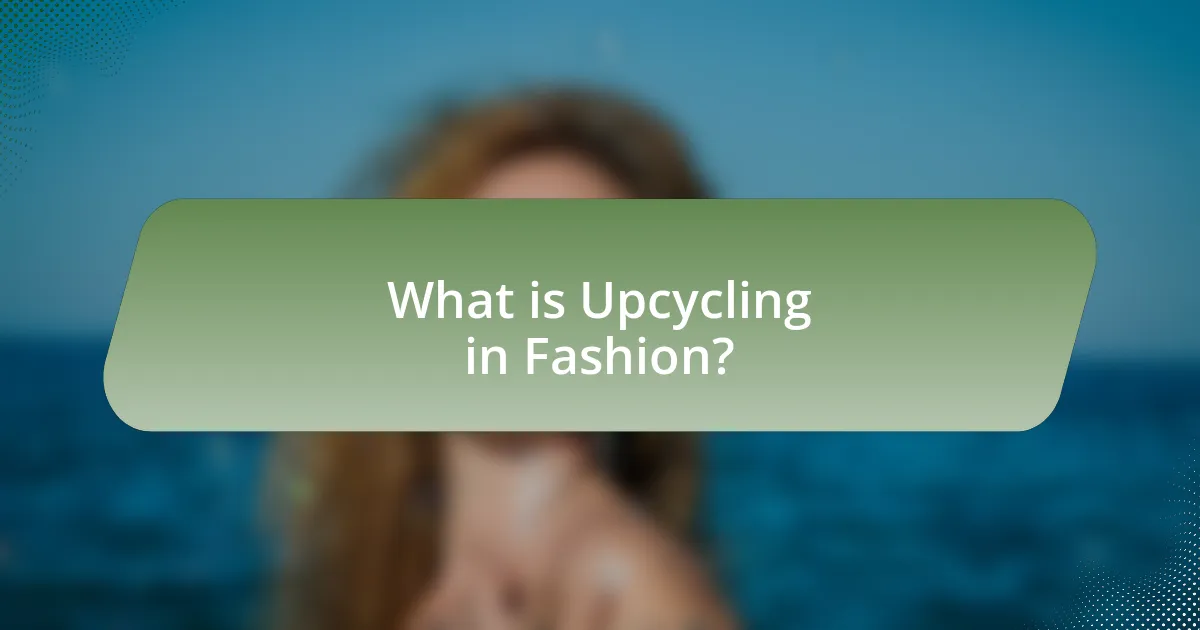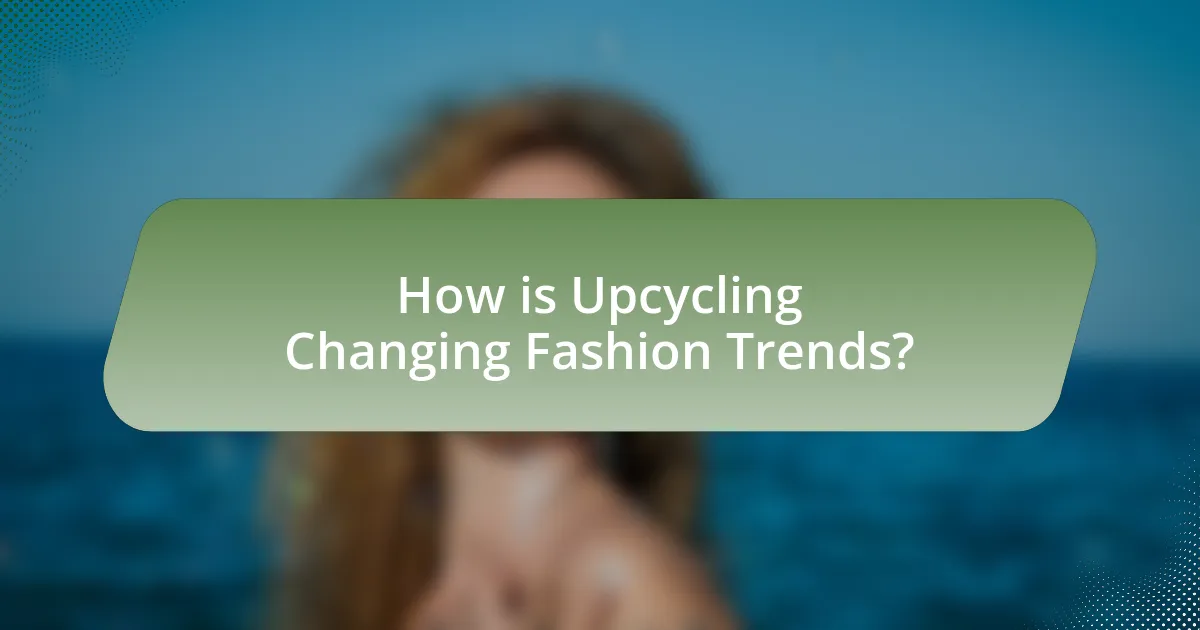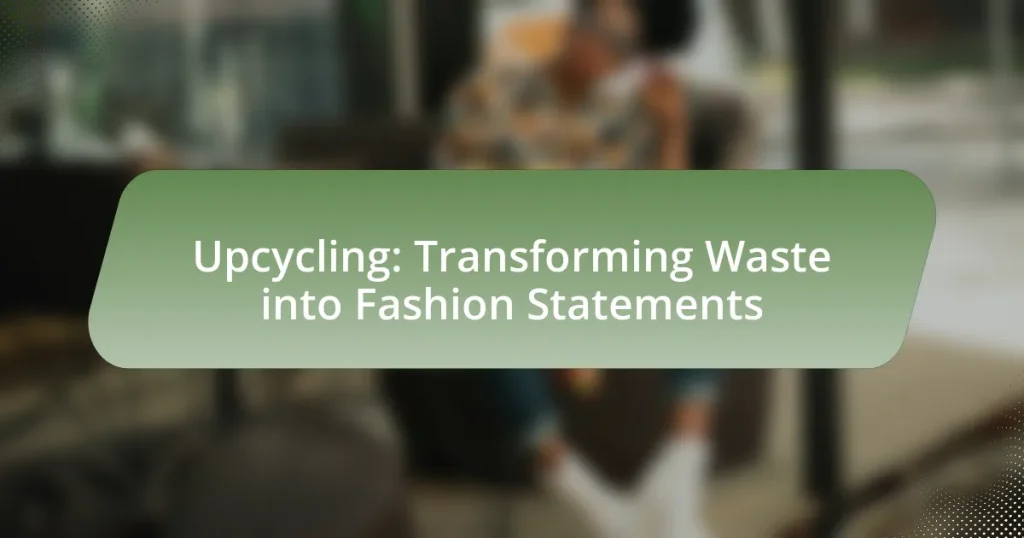Upcycling in fashion is the innovative process of creatively reusing discarded materials or garments to create new, higher-quality products, thereby promoting sustainability and reducing waste. This article explores the distinction between upcycling and recycling, detailing the processes involved in transforming fashion items and the types of materials commonly used. It highlights the environmental benefits of upcycling, including resource conservation and reduced landfill contributions, while also addressing the economic advantages for designers. Additionally, the article examines the challenges faced by the upcycling movement, misconceptions surrounding it, and practical tips for consumers to support and engage in upcycled fashion initiatives.

What is Upcycling in Fashion?
Upcycling in fashion is the process of creatively reusing and transforming discarded materials or garments into new, higher-quality products. This practice not only reduces waste but also promotes sustainability by extending the lifecycle of textiles. According to a report by the Ellen MacArthur Foundation, the fashion industry is responsible for significant environmental impact, with upcycling serving as a viable solution to mitigate this issue by reducing the demand for new resources and minimizing landfill contributions.
How does upcycling differ from recycling?
Upcycling differs from recycling in that upcycling involves creatively repurposing materials into new products with higher value, while recycling breaks down materials to create new raw materials. Upcycling enhances the original item’s value through artistic or functional transformation, such as turning old clothing into fashion accessories, whereas recycling typically involves processing waste into raw materials for manufacturing. This distinction highlights that upcycling focuses on innovation and sustainability, often resulting in unique, handcrafted items, while recycling emphasizes material recovery and environmental conservation.
What processes are involved in upcycling fashion items?
Upcycling fashion items involves several key processes: collection, design, transformation, and finishing. Collection entails sourcing discarded or unused clothing and materials, often from thrift stores or personal wardrobes. The design phase requires creativity to envision new uses for these materials, considering aesthetics and functionality. Transformation involves physically altering the items through techniques such as sewing, dyeing, or embellishing to create a new product. Finally, the finishing process includes quality checks and any necessary adjustments to ensure the upcycled item is ready for use. These processes collectively contribute to reducing waste and promoting sustainable fashion practices.
Why is upcycling considered a sustainable practice?
Upcycling is considered a sustainable practice because it repurposes waste materials into new products, thereby reducing the demand for new resources and minimizing landfill waste. This process conserves energy and raw materials, as it often requires less energy than producing new items from virgin materials. For instance, a study by the Ellen MacArthur Foundation highlights that upcycling can significantly lower carbon emissions associated with production, as it utilizes existing materials rather than extracting and processing new ones. By extending the lifecycle of materials, upcycling contributes to a circular economy, promoting sustainability and reducing environmental impact.
What types of materials are commonly upcycled in fashion?
Commonly upcycled materials in fashion include textiles such as denim, cotton, and silk, as well as non-textile items like plastic bottles, leather scraps, and vintage garments. Denim is frequently repurposed due to its durability and popularity, while cotton and silk are often transformed into new clothing or accessories. Plastic bottles are creatively used to create fabrics like rPET, which is made from recycled PET plastic. Leather scraps are utilized to craft new items, reducing waste from the leather industry. Vintage garments are also upcycled, allowing for unique, one-of-a-kind pieces that promote sustainability.
How can everyday waste be transformed into fashion pieces?
Everyday waste can be transformed into fashion pieces through processes like upcycling, where discarded materials are creatively repurposed into new garments or accessories. For example, plastic bottles can be converted into fibers for clothing, while old denim can be restructured into bags or jackets. This practice not only reduces landfill waste but also promotes sustainable fashion, as evidenced by brands like Patagonia, which uses recycled materials in their products, demonstrating a commitment to environmental responsibility.
What are some examples of upcycled materials used in clothing?
Upcycled materials used in clothing include denim from old jeans, plastic bottles transformed into polyester fabric, and discarded textiles repurposed into new garments. For instance, brands like Reformation utilize post-consumer waste, such as plastic bottles, to create sustainable clothing, demonstrating the viability of these materials in fashion. Additionally, companies like Patagonia have pioneered the use of recycled wool and cotton, showcasing how upcycling can effectively reduce textile waste while maintaining quality and style.
What are the benefits of upcycling in the fashion industry?
Upcycling in the fashion industry offers significant benefits, including reducing waste, conserving resources, and promoting sustainability. By transforming discarded materials into new fashion items, upcycling minimizes the amount of textile waste that ends up in landfills, which is estimated to be around 92 million tons annually according to the Ellen MacArthur Foundation. Additionally, upcycling reduces the demand for new raw materials, thereby conserving water and energy used in the production process. This practice also fosters creativity and innovation among designers, allowing them to create unique pieces that stand out in a saturated market. Furthermore, upcycled fashion often appeals to environmentally conscious consumers, enhancing brand loyalty and marketability.
How does upcycling contribute to environmental sustainability?
Upcycling contributes to environmental sustainability by reducing waste and conserving resources. By transforming discarded materials into new products, upcycling minimizes the amount of waste sent to landfills, which accounted for approximately 292.4 million tons in the United States in 2018. This process also decreases the demand for new raw materials, thereby conserving natural resources and reducing the energy consumption associated with manufacturing. For instance, upcycling one ton of textile waste can save 20,000 gallons of water and prevent the release of harmful chemicals into the environment.
What economic advantages does upcycling offer to designers?
Upcycling offers designers significant economic advantages, primarily by reducing material costs and creating unique products that can command higher prices. By utilizing discarded materials, designers minimize the need for new raw materials, which lowers production expenses. Additionally, upcycled items often attract consumers seeking sustainable fashion, allowing designers to differentiate their products in a competitive market. This differentiation can lead to increased sales and brand loyalty, as evidenced by a 2021 study from the Ellen MacArthur Foundation, which reported that the global market for sustainable fashion is projected to reach $8.25 billion by 2023. Thus, upcycling not only cuts costs but also enhances marketability and profitability for designers.

How is Upcycling Changing Fashion Trends?
Upcycling is changing fashion trends by promoting sustainability and creativity, leading to a shift in consumer preferences towards eco-friendly products. This trend encourages designers to repurpose materials, reducing waste and environmental impact. For instance, brands like Reformation and Patagonia have successfully integrated upcycled materials into their collections, appealing to a growing demographic that values ethical consumption. According to a 2021 report by McKinsey & Company, 67% of consumers consider sustainability when making a purchase, highlighting the significant influence of upcycling on modern fashion trends.
What role do designers play in promoting upcycled fashion?
Designers play a crucial role in promoting upcycled fashion by creatively transforming waste materials into stylish garments, thereby raising awareness about sustainability in the fashion industry. Their innovative designs not only showcase the potential of discarded materials but also challenge conventional fashion norms, encouraging consumers to consider the environmental impact of their purchases. For instance, brands like Reformation and Eileen Fisher have successfully integrated upcycled materials into their collections, demonstrating that sustainable fashion can be both fashionable and eco-friendly. This approach not only reduces textile waste but also inspires other designers and consumers to adopt more sustainable practices, contributing to a broader cultural shift towards responsible consumption.
How are fashion shows incorporating upcycled designs?
Fashion shows are incorporating upcycled designs by showcasing collections that utilize discarded materials and repurposed textiles to create new garments. Designers are increasingly sourcing vintage clothing, fabric scraps, and other waste materials to construct unique pieces that highlight sustainability. For example, brands like Stella McCartney and Reformation have featured upcycled collections in major fashion weeks, demonstrating the viability and aesthetic appeal of these designs. This trend not only reduces waste but also promotes a circular economy within the fashion industry, aligning with growing consumer demand for environmentally responsible practices.
What influence does social media have on upcycled fashion trends?
Social media significantly influences upcycled fashion trends by providing a platform for visibility and community engagement. Platforms like Instagram and TikTok allow designers and consumers to showcase their upcycled creations, fostering a culture of sustainability and creativity. For instance, hashtags such as #upcycledfashion and #sustainablefashion have garnered millions of posts, indicating a growing interest and participation in upcycling. This visibility not only inspires individuals to adopt upcycled fashion but also encourages brands to incorporate sustainable practices into their offerings, as evidenced by the rise of brands like Reformation and Patagonia, which leverage social media to promote their eco-friendly initiatives.
Why is consumer awareness important for upcycled fashion?
Consumer awareness is crucial for upcycled fashion because it drives demand for sustainable practices and influences purchasing decisions. When consumers understand the environmental benefits of upcycled fashion, such as reducing waste and conserving resources, they are more likely to support brands that prioritize these practices. Research indicates that 66% of global consumers are willing to pay more for sustainable brands, highlighting the impact of consumer awareness on market trends. Increased awareness not only promotes ethical consumption but also encourages brands to innovate and adopt more sustainable methods, ultimately contributing to a circular economy.
How can consumers identify upcycled products?
Consumers can identify upcycled products by looking for specific labels or certifications that indicate the item has been made from repurposed materials. Many brands provide information on their packaging or websites about the sourcing and transformation process of their products, highlighting the use of waste materials. Additionally, consumers can recognize upcycled items by examining the uniqueness of the products, as upcycling often results in one-of-a-kind pieces due to the nature of the materials used. Research shows that upcycled products typically have a lower environmental impact compared to new items, as they reduce waste and resource consumption.
What impact does consumer demand have on upcycling practices?
Consumer demand significantly influences upcycling practices by driving the need for sustainable and innovative solutions in fashion. As consumers increasingly prioritize eco-friendly products, brands respond by adopting upcycling methods to meet this demand. For instance, a 2021 survey by McKinsey & Company found that 67% of consumers consider sustainability when making purchasing decisions, prompting brands to incorporate upcycled materials into their collections. This shift not only enhances brand loyalty but also encourages a circular economy, where waste is minimized and resources are reused effectively.

What Challenges Does Upcycling Face in the Fashion Industry?
Upcycling in the fashion industry faces several challenges, including limited consumer awareness, inconsistent quality of materials, and scalability issues. Limited consumer awareness hinders demand for upcycled products, as many consumers are not fully informed about the environmental benefits of upcycling. Inconsistent quality of materials arises because upcycled items often come from various sources, leading to variability in durability and aesthetics. Scalability issues occur as brands struggle to produce upcycled items in large quantities while maintaining cost-effectiveness and quality standards. These challenges collectively impede the widespread adoption of upcycling practices in the fashion sector.
What are the common misconceptions about upcycled fashion?
Common misconceptions about upcycled fashion include the belief that it is of lower quality, that it is only for environmentally conscious consumers, and that it lacks creativity. Many people assume that upcycled items are inferior because they are made from discarded materials; however, numerous designers create high-quality, stylish pieces that rival traditional fashion. Additionally, while upcycled fashion appeals to eco-conscious individuals, it also attracts a broader audience due to its unique designs and artistic value. Lastly, the notion that upcycled fashion is uncreative is incorrect, as many designers showcase innovative techniques and artistic expression in their work, transforming waste into fashionable statements.
How do quality concerns affect the perception of upcycled items?
Quality concerns significantly impact the perception of upcycled items by influencing consumer trust and desirability. When potential buyers perceive upcycled products as lacking in quality, they may associate them with inferior craftsmanship or durability, which can deter purchases. Research indicates that consumers often prioritize quality over sustainability; for instance, a study published in the Journal of Cleaner Production found that perceived quality directly affects the willingness to pay for sustainable products. Thus, if upcycled items are viewed as low-quality, their marketability and acceptance are likely diminished, affecting the overall success of upcycling initiatives in the fashion industry.
What barriers do designers face when sourcing materials for upcycling?
Designers face several barriers when sourcing materials for upcycling, including limited availability of suitable materials, inconsistent quality, and logistical challenges. The limited availability arises because upcycled materials often depend on local waste streams, which can vary significantly in quantity and type. Inconsistent quality is a concern as the condition of discarded items can differ greatly, affecting the final product’s durability and aesthetics. Logistical challenges include difficulties in collecting, transporting, and storing these materials, which can hinder the efficiency of the upcycling process. These barriers collectively impact the feasibility and scalability of upcycling initiatives in the fashion industry.
How can the fashion industry overcome challenges related to upcycling?
The fashion industry can overcome challenges related to upcycling by investing in innovative technologies and fostering collaborations with designers and manufacturers. These investments can streamline the upcycling process, making it more efficient and cost-effective. For instance, advancements in textile recycling technologies can enable the transformation of discarded materials into high-quality fabrics, thus reducing waste and resource consumption. Additionally, partnerships between brands and local artisans can enhance creativity and promote unique upcycled products, as seen in initiatives like the “Circular Fashion” movement, which emphasizes sustainable practices. By prioritizing these strategies, the fashion industry can effectively address the barriers to upcycling and contribute to a more sustainable future.
What innovations are being developed to enhance upcycling processes?
Innovations enhancing upcycling processes include advanced textile recycling technologies, such as chemical recycling methods that break down fabrics into their original fibers, allowing for the creation of new textiles. For instance, companies like Worn Again Technologies are developing processes that can recycle polyester and cotton blends, which are traditionally difficult to upcycle. Additionally, digital design tools and 3D printing are being utilized to create new products from upcycled materials, enabling designers to visualize and produce unique items efficiently. These innovations are supported by research indicating that improved recycling methods can significantly reduce waste and resource consumption in the fashion industry.
How can collaboration between brands improve upcycling efforts?
Collaboration between brands can significantly enhance upcycling efforts by pooling resources, expertise, and consumer reach. When brands work together, they can share innovative techniques and sustainable materials, leading to more effective upcycling processes. For instance, partnerships can facilitate the development of new products from waste materials that might not be feasible for a single brand to tackle alone. Additionally, joint marketing campaigns can raise awareness about upcycled products, increasing consumer interest and demand. A notable example is the collaboration between Adidas and Parley for the Oceans, which transformed plastic waste into high-performance sportswear, demonstrating how shared goals can lead to impactful environmental solutions.
What practical tips can consumers follow to support upcycled fashion?
Consumers can support upcycled fashion by choosing to purchase items made from recycled materials and by seeking out brands that prioritize sustainability. By selecting clothing and accessories that are crafted from upcycled textiles, consumers directly contribute to reducing waste and promoting environmentally friendly practices. Research indicates that the fashion industry is responsible for approximately 10% of global carbon emissions, highlighting the importance of sustainable choices. Additionally, consumers can participate in clothing swaps or buy second-hand items, further extending the lifecycle of garments and minimizing the demand for new production. Engaging in these practices not only supports upcycled fashion but also fosters a more sustainable approach to consumerism.
How can individuals start their own upcycling projects at home?
Individuals can start their own upcycling projects at home by identifying items they no longer use, such as old clothing, furniture, or household materials, and creatively transforming them into new products. For example, turning an old t-shirt into a tote bag or repurposing wooden pallets into furniture are common projects. Research indicates that upcycling not only reduces waste but also promotes creativity and sustainability, as it encourages individuals to rethink the lifecycle of materials. According to a study published in the Journal of Cleaner Production, upcycling can significantly decrease landfill waste and resource consumption, making it an effective practice for environmentally conscious individuals.
What are the best practices for caring for upcycled garments?
The best practices for caring for upcycled garments include gentle washing, air drying, and proper storage. Gentle washing prevents damage to the unique materials often used in upcycled clothing, while air drying helps maintain the garment’s shape and integrity. Proper storage, such as hanging or folding in a cool, dry place, prevents wrinkles and fabric deterioration. These practices ensure the longevity of upcycled garments, which are often made from diverse and delicate materials that require special attention to maintain their quality.




